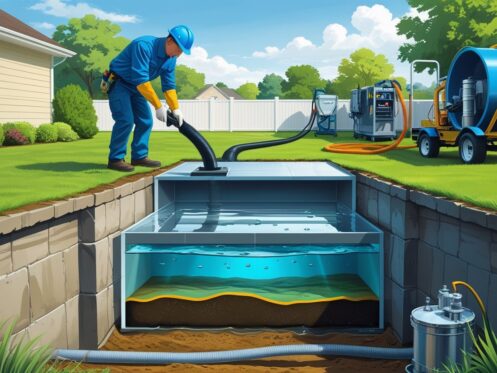Knowing how often your septic tank should be pumped is essential to avoid costly repairs and maintain a healthy home system. Generally, septic tanks need to be pumped every three to five years, but this can vary based on your household size, tank capacity, and water usage. Ignoring this maintenance can lead to backups, slow draining, and unpleasant odors.
Your household’s habits and the size of the septic tank play a major role in determining the ideal pumping schedule. If you use a garbage disposal or have a large family, you may need more frequent servicing. Splash Plumbing can provide expert advice tailored to your specific system and usage to keep your septic tank functioning smoothly.
Regular septic tank pumping helps protect your investment and the environment. If you are near Anaheim, CA, Splash Plumbing is ready to assist with reliable septic services to keep your plumbing in top shape, so you never have to worry about unexpected breakdowns. For more detailed advice on scheduling your septic maintenance, visit how often you should pump a septic tank.
How Often Should Septic Tanks Be Pumped?
Septic tank pumping frequency depends on the size of your tank, the number of people in your household, and your water use habits. Regular pumping prevents backups, foul odors, and costly damage. Knowing when to schedule maintenance keeps your septic system functioning properly and extends its life.
Recommended Pumping Frequency
Most septic tanks need pumping every 3 to 5 years. For example, a 1,000-gallon tank serving a family of four usually fits that range. If your tank is larger or fewer people live in your home, you might extend the time between pumpings.
A general rule of thumb: schedule pumping whenever the sludge and scum layers occupy more than 30% of your tank’s volume. Ignoring this can lead to clogging in your drainage field. If you are unsure about timing, Splash Plumbing can help assess your system and advise you accordingly.
Factors Influencing Pumping Schedules
Several factors affect how often you should pump your septic tank:
- Household size: More residents produce more wastewater and solids.
- Septic tank size: Larger tanks hold waste longer before filling.
- Water usage: High water use speeds up sludge buildup.
- Garbage disposal use: Increases solids entering the tank, requiring more frequent pumping.
- Climate: Wet or rainy regions may impact system performance differently.
Adjusting your pumping schedule based on these elements prevents damage to your tank and environment, helping you avoid emergency repairs.
Adjusting Frequency for Household Needs
Your household’s unique needs determine if you pump more or less frequently than average. For example:
- If you have a large family or use a garbage disposal, pumping every 2 to 3 years could be necessary.
- A small household with conservative water use might extend pumping to every 5 to 6 years.
- Monitor for warning signs like slow drains, odors, or wet spots near your tank, which suggest pumping is overdue.
Regular septic system inspections combined with proper pumping help maintain wastewater flow and system integrity over time. Scheduling service with professionals like Splash Plumbing ensures these tasks are done correctly and on time.
Key Factors Affecting Septic Tank Pumping Frequency
The frequency at which you need to pump your septic tank depends on several precise conditions. Household habits, the type of waste entering the system, and equipment like garbage disposals all play a critical role in managing the tank’s capacity and longevity.
Household Size and Water Usage
The number of people living in your home directly impacts how often your septic tank needs pumping. More residents mean higher wastewater volume, which fills the tank faster. Typically, a household of four may require pumping every 3 to 5 years, but this varies.
Water usage patterns also affect how quickly solids accumulate. High water use, such as frequent laundry or long showers, increases wastewater flow. This can reduce the time between pumpings because solids settle more slowly and the tank fills up quicker.
Regular water-saving habits help extend the pumping interval. Tracking your household size and water consumption provides a clear guideline for septic tank maintenance, helping you avoid unexpected backups or costly repairs.
Type of Waste and Non-Biodegradable Items
What goes down your drains dramatically influences septic tank health. Non-biodegradable items like plastics, wipes, feminine hygiene products, or cooking grease don’t break down and can cause blockages or speed up sludge buildup. These materials add bulk and shorten the time between pumping.
Organic waste breaks down naturally, but non-biodegradables create solid masses, reducing tank capacity and increasing the risk of failure. It’s important to avoid flushing harmful or indigestible items to maintain proper system function.
Managing the type of waste entering your tank slows the accumulation of solids. This can lower how often you need service calls, saving money and preventing damage.
Impact of Garbage Disposal Use
Using a garbage disposal significantly affects your septic tank’s pumping frequency. Disposals increase the volume of solid waste entering the tank because they grind up food particles, which then settle as sludge.
Homes with garbage disposals often require more frequent pumping, sometimes every 1 to 3 years, depending on usage. The additional solids not only fill the tank faster but also increase the risk of clogs and system strain.
If you use a garbage disposal, consider its impact on your septic system’s maintenance schedule. Consulting professionals like Splash Plumbing helps you determine the best pumping interval to keep your septic system functioning reliably.
Understanding Septic System Operation
A septic system treats and disposes of wastewater on your property through a series of steps involving settling solids, separating waste layers, and dispersing liquid safely into the soil. Knowing how these components work helps you maintain your system and determine when pumping is necessary to prevent costly issues.
How Septic Tanks Process Waste
Your septic tank receives wastewater from your household, including water from sinks, toilets, showers, and appliances. Inside the tank, solids settle at the bottom, while oils and lighter materials rise to the surface. This separation allows the clearer liquid in the middle to flow out to the drain field.
The tank provides an anaerobic environment where bacteria break down some solids, reducing their volume. However, not all solids decompose, so sludge accumulates at the bottom over time. Maintaining your septic tank means regularly pumping out this sludge before it overflows into your drain field and causes clogs or failures.
Role of Sludge and Scum Layers
The sludge layer consists of heavier, settled solids that accumulate on the tank’s floor. If left too long without pumping, sludge can compact and harden, becoming difficult to remove and increasing the risk of backups.
The scum layer forms on top of the wastewater and contains grease, oils, and lighter waste materials. While natural bacteria break down some waste, excess scum can block tank outlets and seep into your drain field. Regular monitoring and pumping of these layers help keep your system functioning properly and avoid costly repairs.
| Layer | Description | Risk if Not Pumped |
|---|---|---|
| Sludge | Heavy solids on tank bottom | Clogging, backups, damage |
| Scum | Oils, fats, and light waste | Outlet blockages, failure |
Drain Field Function and Importance
The drain field is critical for safely disposing of the tank’s treated liquid by releasing it into the soil, where natural filtration occurs. It consists of perforated pipes buried in gravel trenches that allow wastewater to seep out slowly.
If sludge or scum escape the tank due to infrequent pumping, the drain field can become clogged. This leads to surface pooling, foul odors, and contamination risks. Proper maintenance of your septic tank, including pump frequency based on your household size and tank capacity, protects the drain field’s function and extends the system’s life.
If you’re near Anaheim, CA, Splash Plumbing can help you schedule inspections and pumping to keep your septic system working efficiently.
Signs Your Septic Tank Needs to Be Pumped
You should watch for specific warning signs of septic tank issues to avoid costly repairs and system failure. These signs include backups, odors, standing water, and inspection alerts related to sludge and scum buildup.
Sewage Backup and Slow Drains
Sewage backup is one of the clearest signs your septic tank needs pumping. If wastewater starts to back up into your sinks, toilets, or drains, it likely means the tank is full and solids are blocking the pipe flow. Slow drains also signal that sludge and scum have accumulated to a point where wastewater cannot flow freely.
Ignoring these issues can lead to septic system failure, causing damage to your plumbing and your property. Immediate pumping can prevent overflow and the need for costly repairs. Consistent backup and sluggish drainage are not normal and indicate your system needs attention.
Unpleasant Odors and Pooling Water
Foul odors near your septic system or drain field often mean the tank is overloaded with solids. These smells result from gases escaping when sludge enzymes level rises too high. If you notice musty or sewage-like smells around your home or yard, it’s time to evaluate your septic tank.
Pooling water or soggy ground near your septic tank or leach field also signals possible overflow or failure due to excess sludge. This water may contain harmful pathogens that could pose health risks. Proper pumping eliminates built-up waste and stops these problems from escalating.
Indicators from Inspections
Regular septic inspections can reveal signs of sludge and scum buildup that aren’t obvious otherwise. Professionals use tools like video sewer line inspections and sludge measurement to assess tank conditions. If an inspection shows solids occupying more than 30-50% of the tank’s volume, pumping is necessary.
An inspection revealing any cracks, leaks, or slow system performance should be followed by immediate maintenance. Scheduled inspections every 1 to 3 years help catch issues before they become severe. If you’re unsure about the tank’s condition, contact Splash Plumbing in Anaheim for expert evaluation and service.
Septic Tank Maintenance Best Practices
Maintaining your septic system properly requires attention to inspection schedules, waste disposal habits, and detailed record keeping. These factors help prevent costly repairs and keep your septic tank pumping on a timely routine.
Scheduling Regular Inspections
Regular inspections are critical to catch issues before they become major problems. You should have your septic tank inspected every 1 to 3 years, depending on tank size and household water use. Inspections assess sludge and scum buildup and check for leaks or damage.
Scheduling inspections alongside pumping appointments optimizes maintenance and extends your system’s life. Professionals use tools like cameras to inspect pipes and tanks without excavation. If you notice slow drains or odors, arrange an inspection immediately.
Proper Waste Disposal Habits
What you flush impacts septic system performance. Avoid flushing non-biodegradable items, grease, or harsh chemicals as they can clog or damage the system. Garbage disposals increase solid waste volume, so tanks may require more frequent pumping.
Use water efficiently to reduce the load on your septic system. Spread out heavy water usage like laundry over several days rather than all at once. These habits reduce stress on the system and decrease the frequency of septic tank pumping needed.
Record Keeping and Professional Service
Keep detailed records of all inspections, pumping, and repairs. This helps track when the next service is due and shows the maintenance history if you sell your home. Accurate records also guide any troubleshooting with your septic system.
Engage licensed professionals like Splash Plumbing to perform septic tank pumping and maintenance. Experienced technicians know how to properly assess and clean tanks to prevent damage. Professional service ensures reliable, safe operation of your septic system over time. For expert assistance in Orange County, consider contacting Splash Plumbing in Anaheim.
Frequently Asked Questions
Septic tank pumping frequency depends on several specific factors, including household size, water use, and system maintenance habits. Understanding these details helps you avoid costly repairs and unpleasant system failures.
What factors influence the frequency of septic tank pumping?
The main factors are tank size, number of occupants, water usage habits, and solids buildup. A larger household or higher water use means pumping is needed more often. Regular inspection can also affect when pumping is necessary.
What are the average intervals for septic tank pumping for different family sizes?
For a small family of 2-3 people, pumping every 3-5 years is typical. Larger families, 4 or more, may require pumping every 2-3 years. Tank size also influences this timeframe. You can find a detailed breakdown at septic system frequency guides like this one from the EPA.
How does regular maintenance affect septic tank pumping schedules?
Routine inspections every 1-3 years help identify issues early, which can extend the intervals between pumpings. Proper maintenance, including avoiding harmful chemicals and solids entering the tank, keeps your system functioning longer and reduces the risk of clogs.
Are there signs that indicate a septic tank needs to be pumped sooner?
Slow drains, unpleasant odors near the septic tank or drain field, sewage backups, and wet spots in the yard above the tank are clear indicators. If you notice these, don’t delay in having your tank inspected and possibly pumped.
What is the typical cost range for pumping a septic tank?
Pumping costs typically range from $250 to $500, depending on tank size and location. Additional repairs or cleaning can increase that cost. It’s wise to contact a reputable local company like Splash Plumbing to get an accurate estimate.
How can one prolong the period between septic tank pumpings?
You can extend pumping intervals by conserving water, avoiding flushing non-degradable items or grease, and scheduling regular inspections. Some use septic treatments to reduce sludge buildup, but routine professional evaluation remains essential to maintain system health.












